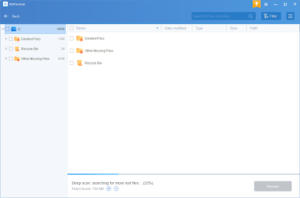Efficient & Quick Way to Perform Windows Recovery
Can permanently deleting files in Windows be recovered?
“Hey, folks! I did the usual file cleanup performance on my Windows 10. After that, I want to get some files back. Are permanently deleted files really gone? In such cases, use Windows Recovery a command-line software tool from My Recover. My Recover can be a viable solution to recover permanently deleted files in Windows 10, offering a range of options to retrieve lost data effectively. Moreover, how can we recover permanently deleted files in Windows 10? Thanks in advance.”
Please be calm because it turns out it can. You can recover permanently deleted files in Windows 10/11 computers because the permanent deletion performance only wipes out the corresponding file paths of your unwanted files instead of the files themselves.

That is to say, users can perform Windows data recovery before data erasure. In brief, there are two feasible solutions for you.
Foresighted users with regular copies can rescue their files straight from backups. But if you fail to develop awareness of data loss prevention, you might need to ask powerful Windows recovery tools for help.
How to recover permanently deleted files in Windows 10/11?
To improve your Windows file recovery rate, please avoid saving new files. Because newly added data can overwrite the free space, where previously saved deleted or missing files.
Recover deleted/lost files via Windows recovery tools
Many users overlook regular copying as a crucial data loss prevention measure. If the habit of creating backups isn’t ingrained, the most efficient and time-saving way is to adopt leading Windows recovery software like MyRecover to recover deleted and missing files.
Backed by its advanced scanning algorithm, MyRecover is good at recovering deleted & lost files from internal and external HDDs, USB sticks, memory cards, etc.
Please get an overview of this professional Windows recovery software below.
Recover deleted or lost data caused by deletion, disk formatting, virus attacks, or system crashes.
Recover 200+ file formats: images (JPG, PNG, DNG, TIFF, etc.), videos (MP4, MOV, AVI, etc.), audio (MP3, WAV, etc.), Microsoft files and WPS files, folders, ZIP, RAR, websites, etc.
Combined scanning method: Automatically run Quick Scan and Deep Scan to detect all the recoverable files. During scanning, you can filter and preview your needed files according to filename, file format, saved path, storage size, deleted date, etc.
Good compatibility: Be compatible with Windows 11, 10, 8, 7, and Windows Server and support four file systems (NTFS, FAT32, exFAT, and ReFS).
Don’t hesitate to download MyRecover to recover permanently deleted files now!
Step 1. After launching MyRecover on your Windows, choose the drive containing permanently deleted files you want to restore > click Start Scan.

Step 2. After clicking Start Scan, MyRecover automatically runs Quick Scan and Deep Scan to detect all the retrievable files on your selected drive.
During scanning, you can filter or preview your desired files quickly according to Filename, Document Type, Path, Size, Date, etc.
Name: Type the relevant filename of your needed files to locate them quickly.
Date modified: Set the date (today, yesterday, last 7/30 days, etc.)
Size: Set the file size (<128KB, 128KB~1MB, 1MB~512MB, etc.)

Step 3. Under the Deleted Files/Recycle Bin/Other Missing Files folder, locate the lost files you intend to retrieve> click Recover x files to finish Windows file recovery.

For those users who are seeking to recover plenty of deleted files from local hard drives, upgrading MyRecover proves to be a financially savvy decision.
Wrapping up
Regarding Windows recovery, start by checking the desktop Recycle Bin after data loss. Please try to restore deleted items from this temporary storage folder if needed. After permanent deletion, it’s advisable to use powerful Windows recovery software to retrieve them, especially for users without regular file backups.
Please consider the following data loss prevention tips to prevent the second damage.
1. Take a moment to review and confirm your choices before deletion.
2. Please avoid haphazardly clearing out your desktop Recycle Bin.
3. Regularly save your work to guard against computer crashes or power failures.
4. Develop the practice of creating file, folder, partition, disk, or system backups via Windows backup options or another free Windows backup software, AOMEI Backupper Standard.

5. Safeguard your Windows system by utilizing Windows virus & threat protection or the most up-to-date antivirus software.




